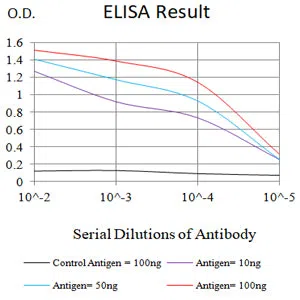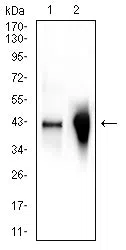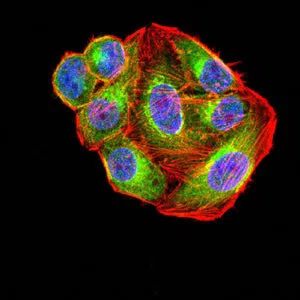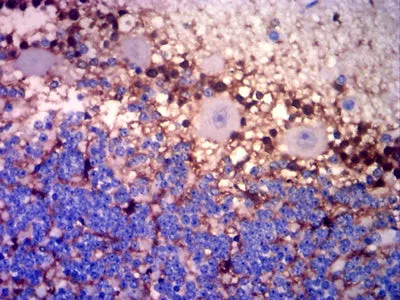




Size:100μL Price:$300
Application:WB,IHC,ICC,ELISA,FC
Reactivity:Human, Mouse
Conjugate:Unconjugated
Optional conjugates: Biotin, FITC (free of charge). See other 26 conjugates.
Gene Name:GLUL
Summary
| Production Name | GLUL Mouse Monoclonal Antibody |
| Description | Mouse monoclonal Antibody |
| Host | Mouse |
| Application | WB,IHC,ICC,ELISA,FC |
| Reactivity | Human, Mouse |
Performance
| Conjugation | Unconjugated |
| Modification | Unmodified |
| Isotype | Mouse IgG1 |
| Clonality | Monoclonal |
| Form | Liquid |
| Storage | Store at 4°C short term. Aliquot and store at -20°C long term. Avoid freeze/thaw cycles. |
| Buffer | Purified antibody in PBS with 0.05% sodium azide |
| Purification | Affinity Purification |
Immunogen
| Gene Name | GLUL |
| Alternative Names | GS; GLNS; PIG43; PIG59 |
| Gene ID | 2752 |
| SwissProt ID | P15104 |
Application
| Dilution Ratio | WB 1:500-1:2000,IHC 1:200-1:1000,ICC 1:200-1:1000,ELISA 1:5000-1:20000,FC 1:200-1:400 |
| Molecular Weight | 42kDa |
Background
The protein encoded by this gene belongs to the glutamine synthetase family. It catalyzes the synthesis of glutamine from glutamate and ammonia in an ATP-dependent reaction. This protein plays a role in ammonia and glutamate detoxification, acid-base homeostasis, cell signaling, and cell proliferation. Glutamine is an abundant amino acid, and is important to the biosynthesis of several amino acids, pyrimidines, and purines. Mutations in this gene are associated with congenital glutamine deficiency, and overexpression of this gene was observed in some primary liver cancer samples. There are six pseudogenes of this gene found on chromosomes 2, 5, 9, 11, and 12. Alternative splicing results in multiple transcript variants.
Research Area
